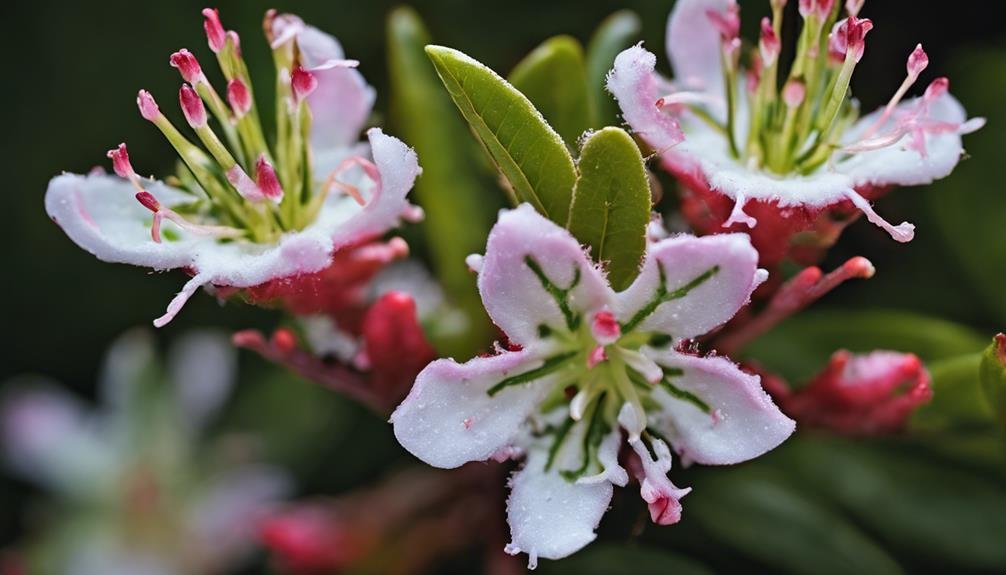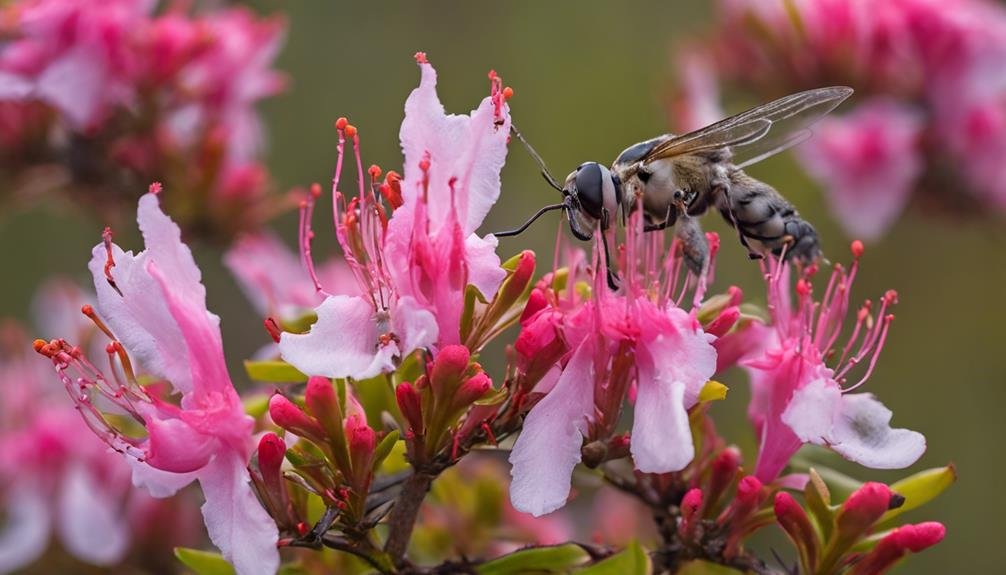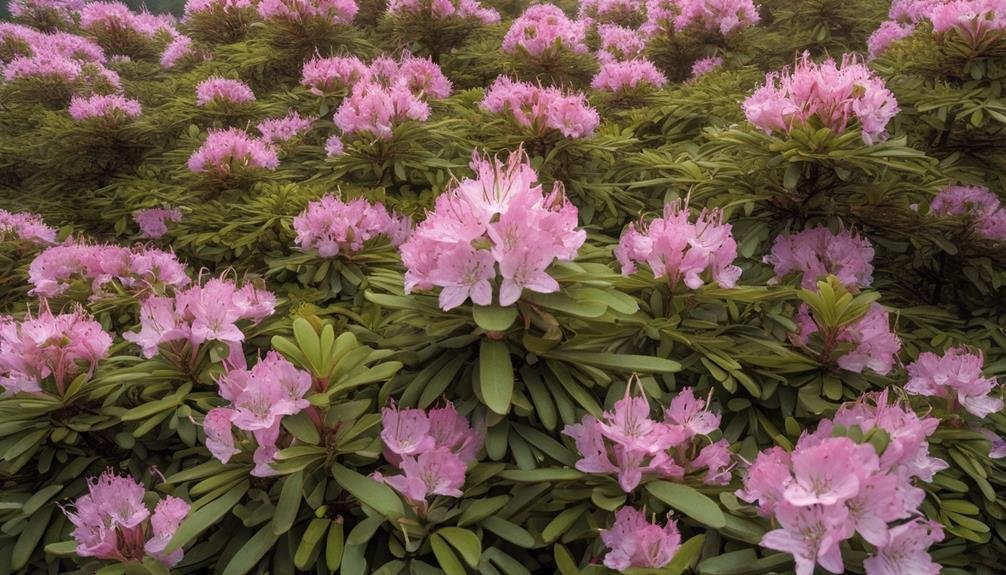What is it about Labrador Tea that captures the imagination and attention of both scientists and herbal enthusiasts? The answer lies in its intriguing blend of beauty, traditional utility, and inherent risks.
Labrador Tea, or Rhododendron groenlandicum, stands as a testament to the complexity and diversity of the plant kingdom, especially in the colder regions of North America.
This evergreen shrub, reaching modest heights of up to 50cm, is not only admired for its striking hemispherical white flowers but also for its leathery, dark green leaves. These leaves, rich in history and folklore, have been used in traditional medicine for various ailments, yet they contain toxic alkaloids that pose potential risks. The dual nature of Labrador Tea—as a source of both healing and harm—presents a fascinating paradox that encourages a deeper understanding of its ecological role, biochemical properties, and the balance between its uses and dangers.
In a high-level overview, Labrador Tea embodies the delicate balance between nature’s gifts and its warnings. The plant’s medicinal history, coupled with its toxic potential, underscores the need for careful study and respect for natural resources. As we continue to learn more about Labrador Tea, it becomes clear that this plant is more than just a part of the landscape; it is a symbol of the intricate connections between humanity and the natural world.
Key Takeaways
- Rhododendron groenlandicum, also known as Labrador Tea, is an evergreen shrub flourishing in boreal forests, notable for its leathery green leaves.
- This plant plays a crucial role in attracting pollinators, highlighting its ecological significance.
- The toxicity of Labrador Tea poses risks to livestock and humans, necessitating careful handling and management.
- Its ornamental and aromatherapeutic uses underscore the benefits of Rhododendron groenlandicum, provided its potential hazards are managed effectively.
A thoughtful approach to the utilization and conservation of Rhododendron groenlandicum is essential, ensuring its advantages are harnessed safely.
Unique Evergreen Shrub Overview
Rhododendron groenlandicum: A Unique Evergreen Shrub
Distinct Characteristics of Labrador Tea
Rhododendron groenlandicum, commonly known as Labrador Tea, stands out as a remarkable evergreen shrub. It flourishes up to a height of approximately 50cm and is notable for its evergreen leaves and hemispherical flower clusters. It has adapted to thrive in the harsh climates of Greenland, Canada, and the United States, showcasing its versatility by growing in diverse habitats such as wet bogs, shores, tundra, and alpine slopes. This resilience underscores the plant’s significant role in North American flora.
Toxicity and Medicinal Use
Despite its appealing appearance, Labrador Tea contains toxic alkaloids, making it poisonous and a potential hazard to livestock and humans if ingested in large quantities. Yet, this very attribute led Native American tribes to harness the plant for medicinal purposes. They brewed it into teas for various therapeutic uses, a practice later adopted by European explorers and settlers, particularly as a tea alternative during the American Revolutionary War. This dual nature of Labrador Tea reflects its complex relationship with humans, balancing between danger and benefit.
Cultural and Medicinal Significance Today
Beyond its ornamental value, Labrador Tea continues to hold cultural and medicinal importance. Its essential oil, derived from the plant, is sought after in aromatherapy, highlighting its continued relevance. This ongoing use of Labrador Tea, from traditional remedies to modern-day aromatherapy, illustrates the enduring legacy and significance of this unique evergreen shrub in various cultural contexts.
Leathery Green Leaves

Adaptations of Rhododendron groenlandicum
One of the remarkable adaptations of the Rhododendron groenlandicum is its leathery upper surface. This particular feature plays a pivotal role in moisture conservation. It’s especially beneficial for the plant’s survival across various environments, ensuring it thrives by minimizing water loss.
Rusty-Wooly Lower Surface as a Defense Mechanism
The rusty-wooly lower surface of its leaves is another significant characteristic of this plant. This adaptation serves as a formidable barrier against herbivores and environmental stresses. It acts as a shield, safeguarding the plant from potential predators and unfavorable conditions, highlighting the plant’s resilience.
Linear-Elliptic Shape for Efficient Photosynthesis
The linear-elliptic shape of the leaves isn’t just an aesthetic feature but also a functional adaptation. This shape is optimized to maximize photosynthesis, the process by which plants use sunlight to synthesize foods from carbon dioxide and water. It ensures that the plant has efficient energy production capabilities, vital for its growth and health.
Green Coloration Enhances Light Absorption
The green coloration of the leaves is crucial for photosynthesis. This color allows for the optimal absorption of light, facilitating the conversion of sunlight into energy. It’s a fundamental characteristic that supports the plant’s ability to generate the necessary nutrients for its survival and development.
Through these unique adaptations, Rhododendron groenlandicum not only demonstrates its ability to withstand environmental challenges but also emphasizes the critical role its leathery green leaves play in its lifecycle. This resilience and adaptability make it a fascinating subject of study in the plant kingdom.
Boreal Forests Presence

Labrador Tea: A Keystone Species in Boreal Forests
In the vast expanses of boreal forests, the Rhododendron groenlandicum, or Labrador Tea, secures its position, flourishing in the cool and moist environment that defines this biome. This plant, belonging to the Heath family, is widespread across territories including Alaska, Oregon, Idaho, Canada, and the northeastern United States, with a strong presence in the New England region. Here, its small, white, five-petaled flowers contribute to the scenic beauty of spruce forests, swamps, and muskeg areas.
Growth and Adaptability
The growth of Labrador Tea varies significantly, from a modest 20 inches to a towering 6-1/2 feet, reflecting its adaptability to diverse conditions within conifer forests. This adaptability plays a crucial role in the boreal forest ecosystem, enhancing its biodiversity and facilitating interactions with local herbivores such as moose, which feed on the plant’s leathery green leaves despite their content of poisonous alkaloids.
Ecological Contributions
Known also as Swamp Tea, Rhododendron groenlandicum is distinguished not only by its leaf characteristics but also by its ecological contributions. It forms an essential part of the boreal forests’ ecological network, demonstrating the intricate relationships that sustain these ecosystems.
Pollinator Attraction Mechanism

Luring Pollinators with Fragrant Blooms
In the lush transitions of seasons, Rhododendron groenlandicum showcases its fragrant white flowers, signaling a feast for the senses of various pollinators. Bees, butterflies, and beetles are drawn to this spectacle, enticed by the dual offerings of nectar and pollen. These elements serve not just as sustenance but as powerful incentives for these creatures to revisit, weaving a web of life that buzzes with activity around the plant.
Nectar and Pollen: The Feast for Pollinators
The allure of Rhododendron groenlandicum goes beyond its visual beauty; it’s about survival and sustenance. The nectar and pollen are the rewards that feed the visiting pollinators, ensuring their survival and return. This exchange isn’t one-sided; it’s a mutual benefit that guarantees the plant’s reproductive success and supports a vibrant ecosystem.
Floral Adaptations for Pollinator Preferences
Each aspect of Labrador Tea’s flowers, from their shape and hue to their unique scent, is a testament to nature’s intricate design. This specialization is aimed at attracting specific pollinator species, a strategy that enhances the chances of cross-pollination. Successful pollination culminates in seed production, ensuring the species’ continued survival and contributing to the genetic diversity and health of the ecosystem.
The Cycle of Propagation and Ecosystem Support
Through the intricate dance of pollination, Rhododendron groenlandicum not only secures its lineage but also plays a crucial role in the maintenance of ecological balance. The plant’s success in attracting pollinators and facilitating cross-pollination is a cornerstone in the broader narrative of ecosystem health, showcasing the interconnectedness of life and the importance of each species in this complex web.
Vulnerability Assessment

In examining the challenges faced by Rhododendron groenlandicum, commonly known as Labrador Tea, it’s imperative to delve into the complexities of its vulnerabilities in its natural setting. The survival of this species is intertwined with a myriad of factors, each playing a unique role in its existence. The goal is to weave these insights into actionable conservation strategies, ensuring the preservation of Labrador Tea for future generations.
The Impact of Habitat Alteration
The encroachment of human activities, notably deforestation, stands as a prime disruptor of Labrador Tea‘s natural habitat. The removal of forests not only strips this species of its home but also upsets the delicate ecological balance necessary for its thrive. Addressing habitat loss requires a nuanced understanding of the interplay between human development and ecological preservation.
The Challenge of Climatic Shifts
Climate change exerts a profound influence on the growth patterns and survival rates of Labrador Tea. Changes in temperature and precipitation patterns can alter the landscape in which this species thrives, calling for adaptive strategies that bolster its resilience against such shifts. The development of climate-smart conservation tactics is crucial in safeguarding the future of Labrador Tea.
Ecological Dynamics and Interactions
The web of ecological interactions, involving pollinators and herbivores, is central to the reproductive success and survival of Labrador Tea. These relationships are delicate and can be easily disrupted by external pressures, affecting the plant’s ability to reproduce and sustain its populations. Understanding these dynamics is key to formulating effective conservation measures.
Monitoring Rare Plant Populations
Keeping a close eye on the populations of Labrador Tea helps in gauging its conservation status and identifying priority areas for protection efforts. Monitoring is a critical tool in the conservation toolkit, enabling the timely identification of threats and the assessment of conservation outcomes. It’s through diligent observation and analysis that we can secure the future of Labrador Tea.
In weaving together these strands of understanding, a comprehensive picture of the vulnerabilities facing Labrador Tea emerges. This knowledge is instrumental in crafting targeted conservation strategies, aimed at mitigating threats and nurturing the conditions for this species’ survival. The journey towards the conservation of Labrador Tea is ongoing, requiring the concerted efforts of communities, conservationists, and policymakers alike.
Frequently Asked Questions
Is Labrador Tea a Sun or Shade Plant?
Is Labrador Tea a plant suitable for shaded areas?
Yes, Labrador Tea prefers shaded environments. It thrives in cool and moist conditions, requiring acidic soil and moderate watering. This plant is well-suited for shaded garden areas due to its high temperature tolerance.
What Is Ledum Groenlandicum Used For?
Q: What is the primary use of Ledum Groenlandicum?
A: Ledum Groenlandicum is primarily used in traditional medicine and herbal remedies for treating skin conditions and respiratory issues. Its aromatic leaves serve as a natural insect repellent and it is also known for its antioxidant properties.
Why Is the Labrador Tea Endangered?
Why is Labrador Tea at Risk?
Question: What are the main threats to Labrador Tea?
Answer: Labrador Tea is not currently endangered but is at risk due to several factors. These include habitat loss, climate change, and the presence of invasive species. Other threats impacting its survival are overharvesting, challenges with pollination, soil degradation, and water pollution. Despite these challenges, Labrador Tea has shown resilience and does not have a limited distribution.
What Are the Precautions for Labrador Tea?
Q: What precautions should be taken when using Labrador Tea?
A: When using Labrador Tea, one must be aware of its potential toxicity and recognize the symptoms that may arise from overconsumption. It is vital for individuals, especially those who are pregnant, to heed warnings and consult a healthcare provider before using this plant due to potential risks. Adhering to recommended dosages is crucial to avoid adverse effects. Users should also be aware of possible allergic reactions and drug interactions. Ensuring safe preparation methods and responsible harvesting practices are important to preserve both personal health and the sustainability of this plant’s use according to traditional practices.
Are Willow Herb and Labrador Tea Safe for Brewing into Teas for Medicinal Use?
Willow herb and Labrador tea have been used traditionally in herbal medicine. However, caution is advised as some species may be toxic. When used correctly and in appropriate doses, these plants can provide health benefits. Understanding epilobium plant benefits, particularly for urinary health and inflammation, adds value to their medicinal use. Always consult an expert.
Do Alpine Arnica and Labrador Tea Share Any Medicinal Benefits?
Alpine arnica and labrador tea both offer anti-inflammatory properties commonly used in traditional medicine. The alpine arnica plant is particularly valued for its ability to reduce swelling and pain when applied topically, while labrador tea has been used for its respiratory benefits. Both plants are popular in natural healing.
Conclusion
In summarizing the characteristics and importance of Rhododendron groenlandicum, known as Labrador Tea, one must reflect on the critical aspects of this evergreen shrub. Thriving in boreal forests, this plant stands out for its leathery green leaves and its role in attracting pollinators, marking its ecological value.
However, the toxic nature of Labrador Tea is a significant concern, posing risks to both livestock and humans. This duality necessitates a thoughtful approach to its management, aiming to preserve its benefits for ornamental and aromatherapeutic uses while minimizing potential hazards.
Understanding the complexities of Rhododendron groenlandicum is vital for its informed utilization and conservation, ensuring that its advantages can be enjoyed safely.


